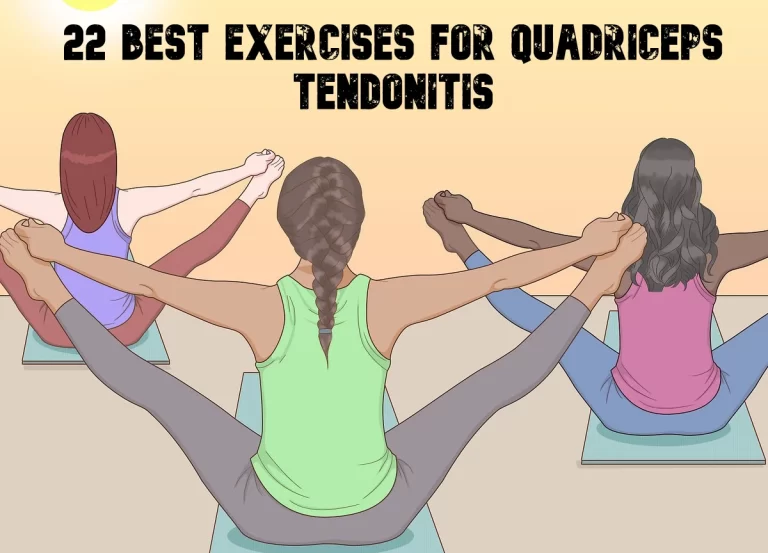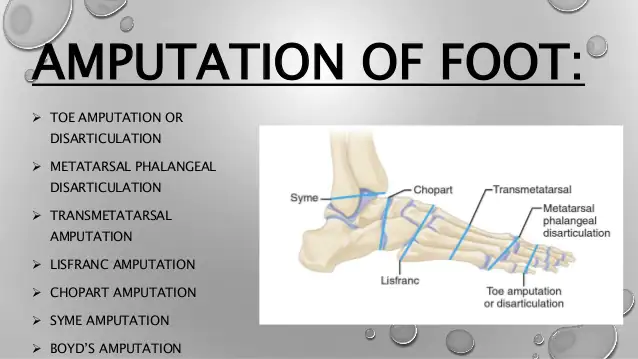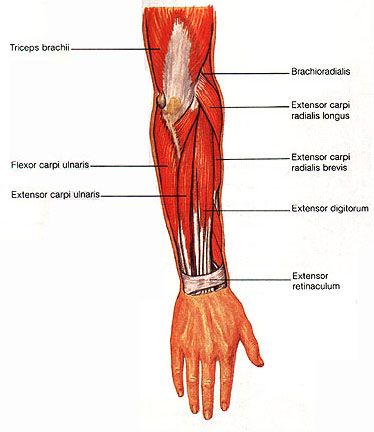19 Best Core Exercises With Bands
Incorporating resistance bands into your core workout routine can add a dynamic element that engages your muscles in unique ways.
These versatile elastic bands provide constant tension throughout each movement, targeting various muscle groups in your core, including the rectus abdominis, obliques, and transverse abdominis.
Whether you’re a beginner or an advanced fitness enthusiast, resistance band core exercises offer a scalable challenge to help you build strength, stability, and flexibility.
The beauty of using resistance bands lies in their portability, affordability, and adaptability to different fitness levels. They can be easily integrated into your home workout or gym routine, providing an effective means of diversifying your core training.
In this guide, we’ll explore some of the best core exercises using resistance bands. From classic moves with an added resistance twist to innovative exercises specifically designed for bands, you’ll discover how to elevate your core workout and achieve a well-rounded, functional midsection. So, grab your resistance bands and get ready to transform your core training experience.
Table of Contents
Introduction
- They generally imagine your abs when you talk about strengthening your core.
- You might be focused in particular on your rectus abdominus, or six-pack muscle.
- Your spine is flexed by the rectus abdominus, a muscular group that runs up and down.
- It serves as the primary mover during crunch.
- However, your abdominals also consist of a deeper collection of muscles beneath the rectus, such as the horizontal muscles, which are your go-to muscles for side bending and rotation, and the transverse abdominus, which has side-to-side muscular fibers that provide both postural stability and rotation.
What are the muscles of the core?
- The hips and lower back muscles are part of your core muscles, and optimal function and posture come from having well-balanced muscles.
- To have a strong core, one must strive for stability and strength in the center of the body.
- Strong posture makes you stand taller, improving both form and function.
- What amount of resistance ought to be applied? The reason endurance matters more than raw strength is that your abs are constantly working to maintain your body.
- In other words, it’s preferable to use minimal or no resistance with a high repeat count over a high rep count with a large amount of weight.
- Having said that, you may improve your strength and endurance a little bit faster quickly with a little bit more stress.
- Resistance bands are an excellent tool because of this.
- While not needing the same level of raw force as hand weights or machines, resistance bands deliver your muscles just the right amount of stress to help them work more.
Exercise for Obliques
An entrance anchor strap that is placed into a doorframe is what I advise using.
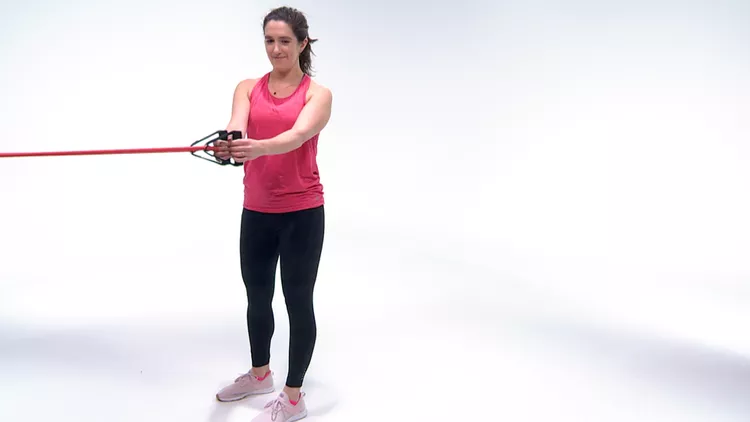
Steps To Follow:
- To work on your belly, adjust the resistance bands to hip height.
- Pull your hands to the right while keeping both handles together for two seconds.
- After 12 repetitions, switch to the left.
- Work up to a third set by doing a second set on each side.
Attempt using a more robust band, move a step away or increase the rep count to 20 from 12. For the 2nd and 3rd sets, you may also vary things up by angling the handles higher or lower. Extend just enough to keep your attention on your core; stay away from your arms or back.
Exercise for Lower Abs
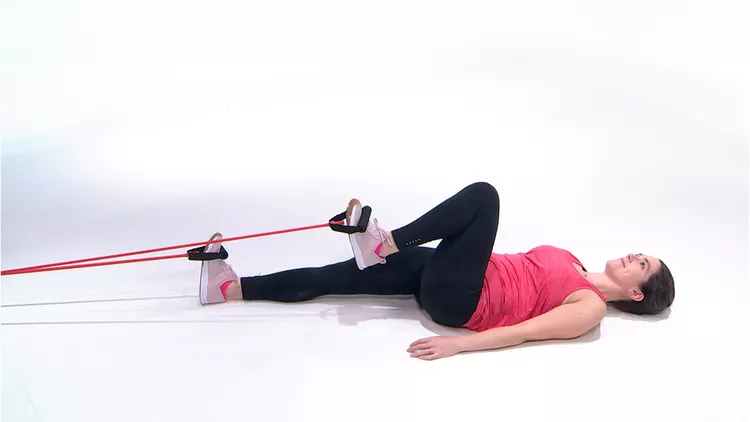
Steps To Follow:
- Pull your shoes through the knobs of your resistance band while keeping your anchor below the door.
- Place your feet at the door and lie on your back.
- One knee at a time, raise it to your chest, and immediately straighten it.
- Perform the same movement on the opposite side, resembling a bicycle crunch except without raising your shoulders off the ground.
- Stabilize your spine and avoid back pain throughout and after this routine by pressing the small of your back against the floor as you repeat for 3 sets of 20.
Increase the number of reps or go to a heavier resistance band.
Exercise for Upper Abs
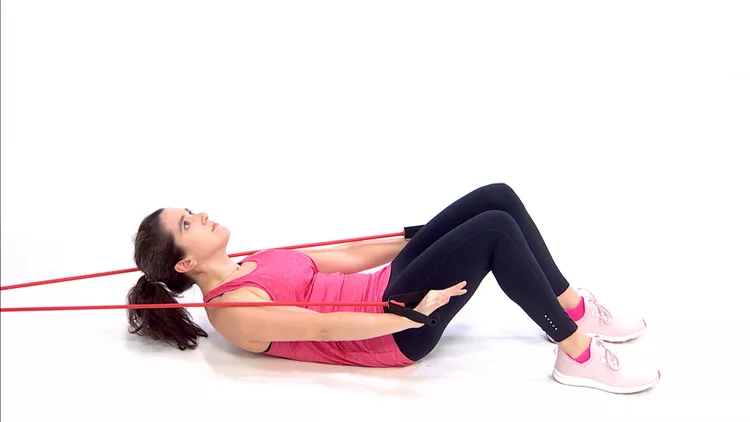
Steps To Follow:
- Go on your back with your head closest to the door, your knees bent, and your feet flat on the ground while the stake is low or beneath the door.
- For additional tension, hold the handles of the resistance bands above your chest and press the bands past your knees as you crunch up.
- Push your lower back on the floor while your shoulders rise off the ground.
- Experience the contraction of your upper core muscles and hold it for two counts.
- Lay back down and bring your hands back to your chest.
- Continue for 3 sets of 15.
Curl up at the shoulders, keep your neck as flexible as possible, and avoid pulling on it.
At the top of the exercise, extend the hold period or swap to a band with greater resistance.
Best Core Exercises With Bands
Exercises using a mini-band
Banded bridge
In order to activate the hip abductors, which are crucial stabilizers of the hip joint and lower back, press into the band.
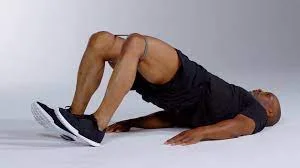
Steps To Follow:
- Sleep faceup on the ground with a little band around the outside of your heels as close to your hips as possible, around shoulder distance apart.
- Maintaining your shoulder blades on the ground, raise your hips and slightly extend your knees.
- Bend the spine back down while keeping a deep scoop in the abdomen.
- Do 10 reps in 2 sets.
Mermaid twist
This workout tones the muscles around your obliques. Aim to maintain your hips stationary while you spin from the waist up for the greatest impact.
Steps To Follow:
- Sitting sideways on one hip, adopt a position resembling a mermaid posture with your knees bent at your sides.
- Using your lower hand, secure the small band.
- Stretch the band as you twist by keeping your spine long and using your upper hand to hold the band close to your chest.
- Make sure your stomach gets all of the strain instead of the shoulders.
- Finish 2 sets of between 6 and 8 repetitions per side.
Banded dead bug
Make sure to maintain an upright, neutral spine throughout the exercise to target the core; avoid arching the back.
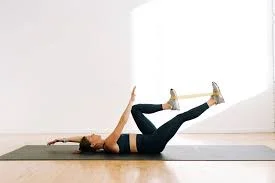
Steps To Follow:
- Hold the little band with the other hand and loop it around one foot.
- Stretch the banded leg and balance the hand and shoulder on the band hand.
- You can reach the unbanded hand overhead to increase the intensity if you’d like.
- To begin, pull your stomach in to help stabilize your spine while you extend and manage your return.
- Finish 2 sets of 10 repetitions on each side.
Banded plank walk
To get the most out of this exercise, avoid overtaxing your pelvic flexors, which can cause your lower back to arch, and instead concentrate on pushing your leg forward with control using the abdominal muscles.
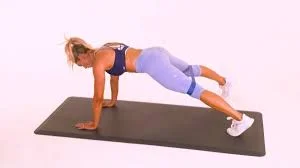
Steps To Follow:
- Place a band around your thighs, a little above the knee, and take a plank posture on your hands or knees.
- Step your legs forward to a bear plank posture, keeping your knees slightly above the floor, and then back to a straight-legged plank, all the while maintaining core stability.
- For harmony, be sure to contract your core muscles and switch up the front leg.
- Finish 2 sets of 8 repetitions, switching to the front leg.
Mountain climbers
Take care not to sacrifice form in order to gain speed.
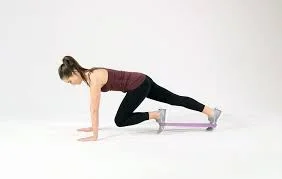
Steps To Follow:
- With the band stretched over both foot arches, proceed to a plank position with your feet hip-distance apart.
- Pull one knee towards your elbows while switching legs to stretch the small band and activate your core.
- Perform 2 sets of 15–20 complete repetitions.
Try these exercises with a flat band.
Controlled rollup
In this case, the band assists you during the ascent portion of the movement. On the way down, it provides you with a reverse curl that eases the upward action while strengthening your back and abdomen.
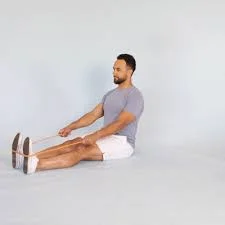
Steps To Follow:
- With both hands, secure a resistance band around your feet while sitting on the floor.
- Pull your stomach down into your spine as you progressively roll your spine down to a supine position.
- With a controlled motion, nod your chin and start to roll back up to a seated position.
- Make sure your arms are as straight as possible to prevent the strain from going to your biceps.
- Finish one 8–10 rep set.
Russian twist
As was previously noted, if you concentrate on stabilizing the hips and rotating from the waist up, your obliques will benefit the most from these workouts. Make sure to maintain a long spine and refrain from compressing the lumbar spine to protect the lower back.

Steps To Follow:
- Having your heels on the ground and your knees bent, assume a V-sit.
- Grasp the ends of the band with both hands and loop it around your feet.
- As you rotate your rib cage and move your hands quickly from hip to hip, stabilize your lower body.
- Continue on the opposite side.
- By raising your feet off the ground and stretching your legs, you can intensify this exercise even more.
- Finish 15 complete reps in 2 sets.
Banded bird dog
During this exercise, maintain your core connected and focus on moving the band using your hamstrings and shoulder muscles. Although it’s simple to arch your lower back, try to maintain a strong, long spine.
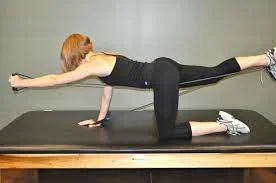
Steps To Follow:
- Remaining on your hands and knees, secure one end of the band around the arch of one foot and hold it with your other hand.
- Stretch the banded knee and arm at the same time.
- Maintain a stable spine, tense the muscles of your abdomen, and strive for fluid movement.
- Finish 2 sets of 10 repetitions on each side.
Banded wood chop
Try your best to pull the band with your hands after rotating from the torso.
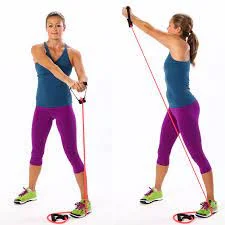
Steps To Follow:
- Place your forward foot to stabilize one end of the band while you adopt a split stance.
- The opposite end of the band is grasped in both hands.
- Keep your core muscles firm and your hips steady as you rotate in the direction of the rear leg, raising your arms to stretch the band.
- Finish 2 sets of 10 repetitions on each side.
Palov press
The abs are worked in their role as stabilizers with the Palov press. In this situation, the resistance is pulling on your body, therefore you’re attempting to keep your torso still.
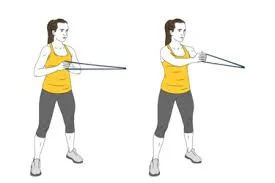
Steps To Follow:
- Turn the band 90 degrees to the side and attach it at shoulder height.
- Pull the elbows back towards your chest after extending your arms and moving away from the anchor until you feel the proper level of strain.
- Extend your elbows slowly while keeping the band tight throughout the motion.
- As you extend your arms in front of you, try not to turn around.
- To get back to the starting posture, bend your elbows.
- Do 10 reps in 2 sets.
- Remember you complete both sides.
Double leg stretch
During the exercise, try to keep your lower back in contact with the floor and keep your spine in a neutral position.
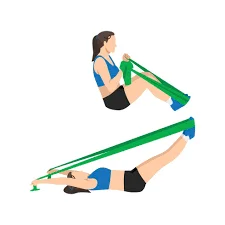
Steps To Follow:
- With your feet off the floor, create a tabletop position while lying on your back.
- Bend your legs at the hips and knees to a 90-degree angle.
- Hold the ends of the band in your hands and wrap the middle over your feet.
- Draw both of your legs out from the center and control their return while lowering your abs towards the floor.
- You can raise your head and shoulders off the floor and extend your arms overhead to increase the difficulty of this workout.
- Perform one 12- to 15-rep set.
Resistance band core exercises to feel the burn
Standing knee tuck
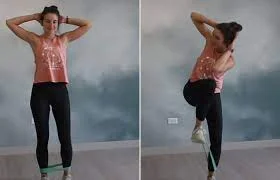
Steps To Follow:
- With your feet spaced somewhat wider than hip-width apart, stand up and wrap the resistance band around your midfoot.
- Bend your right elbow towards the left knee while raising your left knee towards your chest.
- Without bending over, try to bring your knee to your elbow.
- Go back to the beginning and repeat the process on the opposite side.
- Continue changing things up.
Hollow body roll
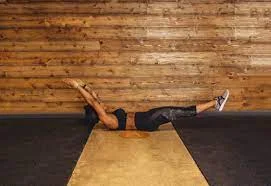
Steps To Follow:
- With your arms straight above and the resistance band looped over the wrists, lie faceup.
- For a hollow hold, elevate your legs and shoulders off the ground.
- Then, with your arms extended and your biceps close to your ears, roll your body to the right using your core.
- Once you’ve arrived at the starting point, roll back left.
- That amounts to one rep.
Bicycle crunch
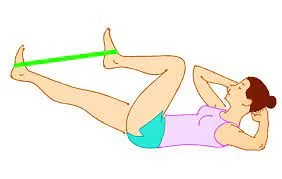
Steps To Follow:
- Having the resistance band looped around your feet, knees bent, and heels flat on the floor, begin in a seated position.
- Lightly press your fingertips to the back of your ears while bending back to a 45-degree angle to activate your core.
- As your right leg straightens, use your core to spin at the waist, pushing your right elbow near your left knee.
- Next, as your left leg straightens, turn your torso to bring your left elbow to your right knee for one rep.
- Continue switching it up.
Side plank
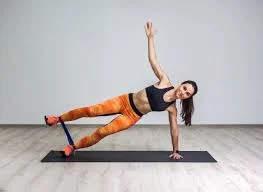
Steps To Follow:
- Start with placing the resistance band over your ankles and assuming a high plank position.
- Put your left hand on your hip, stack your feet, and shift your weight to your right hand.
- When your toes are approximately hip-width apart, raise your left foot off your right and keep it there for as long as you can, preferably for 30 seconds.
- Go back to the start and repeat the process on the opposite side.
Single-leg T row
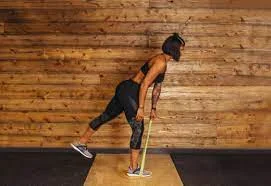
Steps To Follow:
- Holding the other end in your left hand, stand with your feet hip-width apart and loop the resistance band around your right foot.
- Place your weight on your right leg, bend forward at the hips, and extend your left leg behind you.
- Sending the left elbow straight back and maintaining it close to your side, draw the resistance band towards you once your chest is parallel to the floor. Arm extended; then take a step back to where you started.
- Complete the reps, then switch to the opposite side.
Spiderman push-up
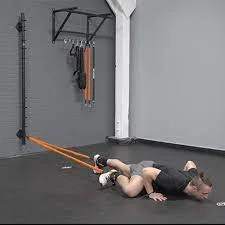
Steps To Follow:
- Having the resistance band around your feet, your wrists directly beneath your shoulders, and your core activated, begin in the high bench position.
- Draw your right knee to contact your right elbow while lowering your chest to perform a push-up.
- Return to the starting position by pushing, then perform one repetition on the opposite side.
T rotation lunge
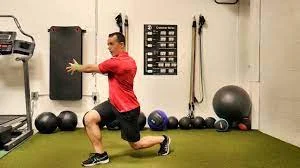
Steps To Follow:
- Arrange your arms straight in front of you as you stand.
- The resistance band should be placed shoulder-width apart.
- Return to a lunge, step your right foot back until your thigh is level with the floor.
- Spin your torso to the right using your core, stretching the resistance band as much as you can.
- Put your right heel through to get back to the starting position.
- Finish the reps, then switch to the opposite side.
Unilateral squat
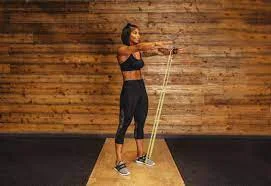
Steps To Follow:
- Place the resistance band below the ball of your left foot and around your left wrist while standing with your feet slightly wider than hip-width apart and your toes brought forward.
- Keep your chest raised as you extend your arms straight in front of you and lower your hips into a squat.
- Go back to where you were before.
- Finish the reps, then switch to the opposite side.
Benefits of Resistance Band Workouts
- Exercises using resistance bands make it simple to tone and strengthen without putting additional strain on your joints.
- You can fit in a fast workout in almost any place including when you’re short on time because the bands are portable.
- Lower back discomfort can be reduced and your spine stabilised by strengthening your core.
- In one study, participants with persistent low back pain were found to benefit from resistance band workouts in the following ways:
- Decreased back pain
- Improved core strength
- Increased flexibility
- Resistance band workouts even showed greater improvement in the research than did yoga.
- The following three resistance band workouts can help strengthen your core and give you better abs.
- With three minutes dedicated to each part of the core and a break to reset your bands between each action, the whole routine can be completed in 10 minutes.
- Always inhale when your bands are at their lowest tension and exhale when they are at their highest.
- Never extend resistance bands past a point where it won’t pull you unintentionally.
- Instead, switch to a band with more tension or add a second band to boost resistance.
Safety advice for abs exercises using resistance bands
- Before each workout, it’s important to inspect the band for any little tears.
- You want to avoid getting popped in the face by a breaking band because elastic can snap.
- Don’t risk replacing your band if you discover little tears or nicks in it.
- Particularly when managing with the progressive challenge, form matters.
- You probably move more carefully during the contraction of the muscles (concentric) phase, but it’s simple to lose control of your movements during the muscle extension (eccentric) phase.
- But doing so can harm connective tissue as well as muscle.
- Making sure that stress is released gradually helps improve strength and lower the chance of injury.
Conclusion
Resistance bands are practical equipment for on-the-go exercises. They can provide enough resistance to improve strength and endurance, they are lightweight and portable, and they have enough variation to make workouts interesting. It has never been so simple to improve your posture and core strength.
FAQ
Resistance bands, which are often composed of rubber, provide varying degrees of resistance, which helps to build and sculpt the muscles. Not just the rectus abdominus, but all the core muscles are effectively worked out with the band exercises for abs.
Natural rubber resistance bands typically last six to ten months before showing symptoms of deterioration. Synthetic rubber resistance bands usually last longer, although they need to be changed every two years.
According to research, utilising elastic resistance bands can provide strength increases that are comparable to those obtained from training with dumbbells or weight machines, which is advantageous for both regular people and athletes. Compared to weight training, resistance-band training can even strengthen the stabilizing muscles more.
How much resistance ought to be applied? The reason endurance matters more than raw strength is that your abs are constantly working to maintain your body. In other words, it’s preferable to use minimal or no resistance with a high repetition count rather than a high rep count with a large amount of weight.
Generally speaking, you can work out with resistance bands six days a week to gain lean muscle mass or you can work out with your entire body to improve your athletic performance. You may easily use resistance bands up to six times a week as long as you make sure to allow yourself a proper recovery period in between workouts.
References:
- Borgenicht, N. (2023, March 28). This 10-Minute Resistance Band Ab Workout Will Work Your Entire Core. Health. https://www.health.com/fitness/resistance-band-ab-workout
- Mateo, A. (2021, July 30). 8 Core-Strengthening Resistance Band Moves You Can Do Anywhere. Greatist. https://greatist.com/fitness/resistance-band-core-exercises-massy-arias#benefits
- Cpt, T. C. (2021, June 25). Resistance Band Workouts for Abs: 11 Exercises to Try. Healthline. https://www.healthline.com/health/fitness/resistance-band-workouts-abs


